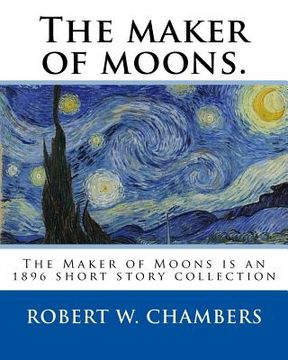The maker of moons. By: Robert W. Chambers, and By: Walt Whitman: The Maker of Moons is an 1896 short story collection by Robert W. Chambers w (en Inglés)
Reseña del libro "The maker of moons. By: Robert W. Chambers, and By: Walt Whitman: The Maker of Moons is an 1896 short story collection by Robert W. Chambers w (en Inglés)"
Walter "Walt" Whitman ( May 31, 1819 - March 26, 1892) was an American poet, essayist, and journalist. A humanist, he was a part of the transition between transcendentalism and realism, incorporating both views in his works... The Maker of Moons is an 1896 short story collection by Robert W. Chambers which followed the publication of Chambers' most famous work, The King in Yellow (1895). It contained eight new stories, including the title story "The Maker of Moons", one of his weird tales, and several romantic Art Nouveau stories, concluding with two less distinguished weird tales. The latter were subsequently incorporated into the episodic novel In Search of the Unknown. The first three stories are linked by the theme of a dream wife who is named Ysonde, and they form a triptych. The weird nature of the first story has interesting echoes in the other two, which feature picturesque animal figures, such as a Red Ibis and a disagreeable porcupine. The story "In The Name of the Most High" is a war story set in the American Civil War. The next two stories are humorous romantic tales with a fishing theme and setting. Chambers' love of natural scenery illuminates most of the stories. The quality throughout is rather fine. Published by Putnam's, New York and London, in 1896. The first edition featured a frontispiece with a black and white illustration by Lancelot Speed. Contents: "The Maker of Moons" "The Silent Land" "The Black Water" "In the Name of the Most High" "Boy's Sister" "The Crime" "A Pleasant Evening" "The Man At The Next Table"... Robert William Chambers (May 26, 1865 - December 16, 1933) was an American artist and fiction writer, best known for his book of short stories entitled The King in Yellow, published in 1895.He was born in Brooklyn, New York, to William P. Chambers (1827-1911), a corporate and bankruptcy lawyer, and Caroline Smith Boughton (1842-1913). His parents met when Caroline was twelve years old and William P. was interning with her father, Joseph Boughton, a prominent corporate lawyer. Eventually the two formed the law firm of Chambers and Boughton which continued to prosper even after Joseph's death in 1861. Robert's great-grandfather, William Chambers (birth unknown), a lieutenant in the British Royal Navy, was married to Amelia Saunders, (1765-1822), the great grand daughter of Tobias Saunders, of Westerly, Rhode Island. The couple moved from Westerly, to Greenfield, Massachusetts and then to Galway, New York, where their son, also William Chambers, (1798-1874) was born. The second William graduated from Union College at the age of 18, and then went to a college in Boston, where he studied to be a doctor. Upon graduating, he and his wife, Eliza P. Allen (1793-1880), a direct descendant of Roger Williams, the founder of Providence, Rhode Island were among the first settlers of Broadalbin, New York. His brother was architect Walter Boughton Chambers. Robert was first educated at the Brooklyn Polytechnic Institute, and then entered the Art Students' League at around the age of twenty, where the artist Charles Dana Gibson was his fellow student. Chambers studied at the École des Beaux-Arts, and at Académie Julian, in Paris from 1886 to 1893, and his work was displayed at the Salon as early as 1889. On his return to New York, he succeeded in selling his illustrations to Life, Truth, and Vogue magazines. Then, for reasons unclear, he devoted his time to writing, producing his first novel, In the Quarter (written in 1887 in Munich). His most famous, and perhaps most meritorious, effort is The King in Yellow, a collection of Art Nouveau short stories published in 1895. This included several famous weird short stories which are connected by the theme of a fictitious drama of the same title, which drives those who read it insane.E. F. Bleiler described The King in Yellow as one of the most important works of American supernatural fiction.It was also strongly admired by H. P. Lovecraft and his circle
Walt Whitman (1819-1892) es, sin lugar a dudas, el poeta más influyente de las letras estadounidenses. Nació en West Hills, Long Island, siendo el segundo de nueve hijos en una familia cercana al credo cuáquero. A los once años finalizó sus estudios formales y empezó a trabajar como aprendiz en el semanario The Patriot, donde comenzaría a escribir sus primeros textos. Tras su paso por otros periódicos y revistas, en 1850 decidió dedicarse plenamente a la poesía. Cinco años más tarde vería la luz la primera edición de la celebérrima Hojas de hierba, integrada por doce poemas y cuyos 795 ejemplares fueron costeados por el mismo autor. El poemario despertó gran interés y fue ampliamente distribuido, en parte por la fascinación que despertó en el filósofo Ralph Waldo Emerson. Durante la Guerra de Secesión, Whitman ejerció voluntariamente como enfermero en Washington D.C., experiencia que recogería en El gran ejército de la enfermedad (1863) y Memorias de la guerra (1875). Finalizado el conflicto en 1965, publicó Redobles de tambor. Mientras se empleaba en la Oficina del Fiscal General, Whitman siguió alzando la pluma para escribir versos como los de «¡Oh, Capitán! ¡Mi Capitán!», que, junto a otros, irían completando las sucesivas ediciones de Hojas de hierba hasta la novena y definitiva, que constó de un total de más de cuatrocientos poemas.
Ver más
Ver menos

